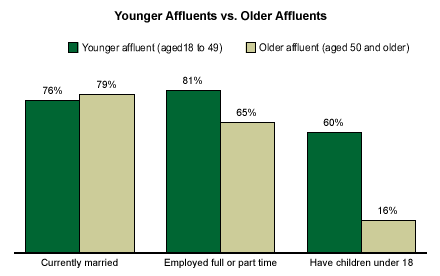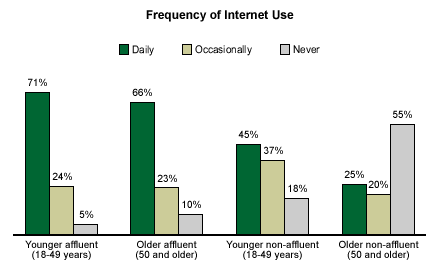Over the last few decades, there has been a rapid rise of affluence in America. According to 2003 Census figures, one in every four households in the country is now "mass affluent," -- defined as people living in households with annual incomes of $75,000 and higher -- compared with only about one in seven in 1980. This article is the sixth in a series examining this demographic segment and focuses on older affluents.
Marketers used to believe that it was a waste to spend advertising dollars trying change older consumers' behavior or brand preferences -- they bought the conventional wisdom that older Americans are set in their ways. But a 2002 study conducted by the AARP and RoperASW found that Americans aged 45 and older were just as likely as younger Americans to switch brands and try new products. Given the 2001 U.S. Census report that this market segment accounts for assets of $28 trillion -- 67% of the wealth in the country -- corporate America can't afford to overlook them.
Demographic Characteristics
About one in every three affluent Americans (36%) are aged 50 and older*. Nationally, 41% of the U.S. adult population is 50 or older, according to Gallup research. (The July 1, 2003, U.S. Census puts this figure at 38%.) So, older Americans are slightly less common among affluents than they are among the population at large. Only 8% of affluents, but 20% of non-affluents, are 65 and older.

Empty Nesters
About four in five older affluents are married, similar to the percentage among younger affluents. Most are employed full or part time, although the rate is higher among younger affluents (81%) than older affluents (65%). What older affluents lack are young children: Only 16% of older affluents have children under 18, compared with 60% of younger affluents. As a result, older affluents are free from the time and stress pressures that come from parenthood -- themes evident among middle-aged affluents.

No Kids = Less Stress
Given their empty-nester status, it stands to reason that older affluents might be more relaxed -- and Gallup's research shows this to be true: 41% of younger affluents say they have the time they need to do the things they want in life, and 4 in 10 say they are frequently stressed. In contrast, 6 in 10 older affluents say they have enough time, and only 28% report they are frequently stressed.
Internet-Savvy Bookworms
Affluent Americans aged 50 and older read an average of 20 books a year, compared with 14 books read by younger affluents. This book reading is in addition to regular Web surfing. Because most older affluents are still in the workforce, they are nearly as Internet savvy as younger affluents. In fact, there is relatively little generational difference in Internet use among affluents -- just a five-point difference in the percentage who use the Internet daily (71% of younger affluents versus 66% of older affluents). Yet older affluents are given short shrift by marketers, who tend to target their Internet-based campaigns at younger consumers.

Bottom Line
In many ways, older affluents are more similar to young affluents than they are to older non-affluents. They lead active lifestyles (see "Fat Cats Living Up to Their Name?" in Related Items), they work, they're married, and they're connected to the Internet. Armed with time and money, older affluents seem poised to embrace experiences that can enrich them in other ways -- from vacations and health clubs to wine-tasting classes. So, providing products and services that match their taste for an active lifestyle and fine living could be rewarding for marketers who are savvy enough to appeal to this discerning group.
*These results are based on aggregated Gallup surveys spanning 2001-2003. Each aggregate is based on telephone interviews with approximately 3,000 national adults, aged 18 and older. Depending on the specific question (and how many years out of the three it was asked), the number of older affluents looked at in this analysis ranges from 106 to 293.
